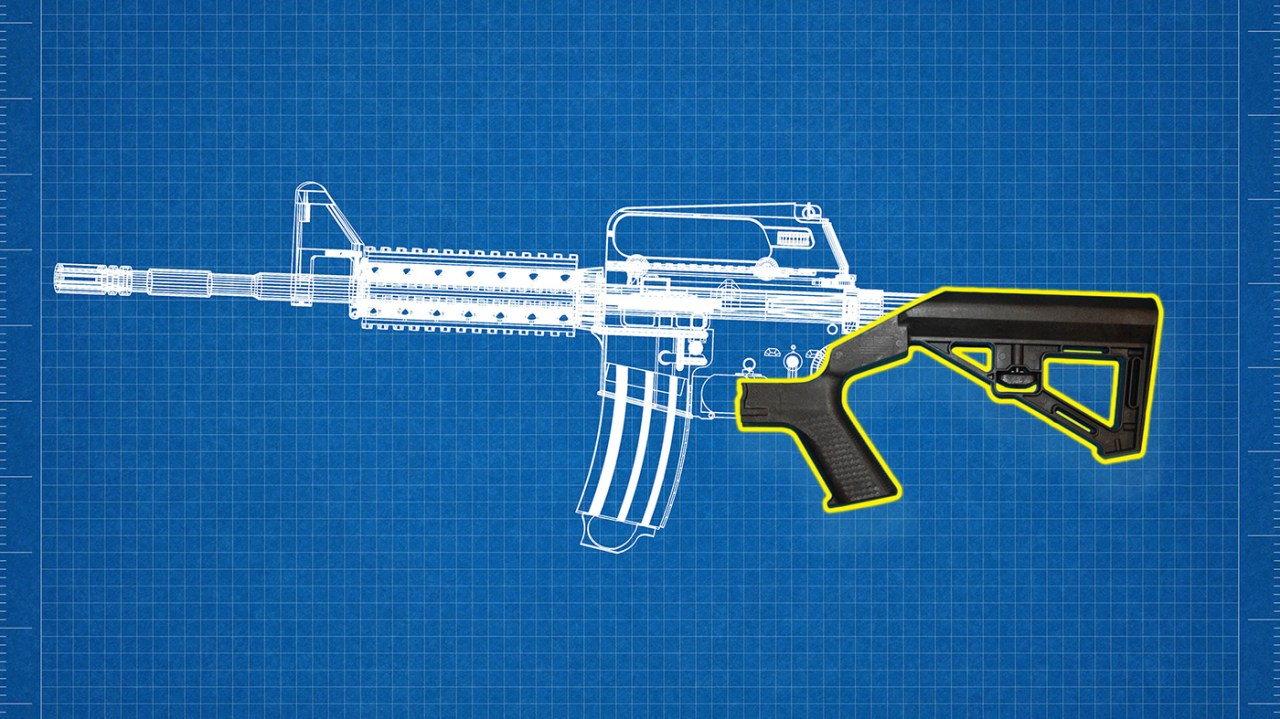cross-posted from: https://lemmy.world/post/15645865
If the Supreme Court rules that bump stocks aren’t machine guns later this summer, it could quickly open an unfettered marketplace of newer, more powerful rapid-fire devices.
The Trump administration, in a rare break from gun rights groups, quickly banned bump stocks after the 2017 mass shooting at a Las Vegas concert that was the deadliest in U.S. history. In the ensuing years, gun rights groups challenged the underlying rationale that bump stocks are effectively machine guns — culminating in a legal fight now before the Supreme Court.
A machine gun is defined by the NFA of 1934 using very specific terms. Bump stocks do not meet these terms. There is only one way this will shake out.
bump stocks were not a thing when the definition of a machine gun was formally defined.
we have got to introduce a system where we update definitions and laws that are clearly out-of-date, but we all know why this hasn’t happened yet…
There is a “system” to update statutory definitions - It has to pass Congress. The Executive cannot unilaterally do this. It is a feature, not a bug.
Yeah only that’s not true in practice as the atfe changes their own rules all the time.
Rules-making agencies have to conform to the the statute when issuing rules. They can interpret within the bounds defined by the law, but they aren’t allowed to invent regulation wholesale.
That’s kind of the point of this suit. The ATF’s rule appears to conflict with the statutory text; if the court decides that to be the case, then the statute takes precedent and the rule gets invalidated.
there’s no winning.
.
I think the phrase “or combination of parts designed and intended, for use in converting a weapon into a machinegun” will come into play.
It speaks more of intent than the ‘single trigger pull’. If your intent is to turn a semi-automatic into a functional full-automatic, this would be the phrase that makes that gun a “machinegun”.
We will have to see how it plays out in court.
.
Same as using a belt loop
Law is weird. Sometimes courts rule according to the letter of the law, but often courts rule according to the “intention” of the law. There’s often a difference between what a law says and what it really intended.
I mean it’s pretty clear that a law regulating machine guns is meant to affect any firearm that can achieve rapid automatic firing. Lawyers are not engineers or fortune tellers, they should not have to make many mechanical distinctions, and they cannot predict what technologies might be developed in the future. The point of the law is not to regulate mechanical methodology or inner workings, it’s meant to regulate the ultimate functionality of a firearm and the resulting outcomes. Judges and Lawyers understand this and they will sometimes (but not always) make rulings accordingly.
Yeah, they defined a lot of things differently then. They defined legal voters as whites only, should we rely on that definition too?
Edit: I’ll assume the downvotes are yeses
If there’s one thing the us needs, it’s a way for people to shoot each other more effectively.
The “funny” thing is: We don’t. This is all a red herring/sacrificial lamb by the gun nuts to make people think legislature is doing anything.
The two most common rounds used in mass shootings in the US are the 5.56 mm/.223 (AR-15/M-4 round) and the 9mm pistol round. And while the type of round matters a lot, the commonly used variants of each tend to not over-penetrate to a significant level. What that means is that when it hits a kindergartner it stays in the kindergartner and tends to not cause significant damage to the Bluey stuffy they were protecting.
Which, combined with the fact that militaries generally strongly frown upon (if not disable) full automatic fire on rifles, means that fire rate beyond “it is semi-automatic and fires as fast as you squeeze the trigger” is not important. Rapidly squeezing a trigger is considerably more effective than holding a rifle in just the right way to utilize a bump stock or just holding down a trigger to mag dump.
But it provides a “culture war” talking point so that people can feel like concessions are being made when you can still buy almost exactly the same rifle we are giving special forces at a walmart.
Unless we ban all semi-automatic/double-action firing mechanisms (which I would actually be very okay with and consider a genuinely good compromise), rate of fire is largely irrelevant. People aren’t going to be able to flee any faster from someone dumping a magazine with a single trigger pull or a jiggly bullshit.
What matters are getting rid of fucking AR-15s (there is a REALLY good and horrifying article that goes into why the 5.56 round is so fucked up. Well worth googling) and drastically reducing magazine capacities.
AR-15s are rarely used to kill people. Handguns are used in 90+% of all gun homicides.
556 is not some magical round, it’s weaker than a normal hunting round. My AR10 shoots 308 and my 458 socom AR rounds are bigger than that.
Im not so sure I would completely throw out indescriminate fire as not being bad but overall I agree with you. If you think about legitamate uses of guns I don’t see any that require more than the shooter outside of convenience (or you could argue a really bad shot needs it but I would argue maybe they should not have a gun outside of a range until they get gud).
Indiscriminate fire is bad. But full auto or even “bump stock” auto just increases the odds that you shoot the same kindergartener twenty times rather than all of Mrs Anderson’s class.
Politicians and lobbyists LOVE to make the argument about rate of fire. Because there is more or less an understanding that it is pointless to fixate on and is “safe” to ban. Even army machine gunners are trained to fire in VERY short bursts (if not single shots) unless they are trying to hit a target at long range.
I was in the US Marine Corps and deployed with the front lines for the 2003 Invasion of Iraq. I never once even considered putting my M-16 on burst. I also had a 240G, which we’re taught to fire in little burts, about the time it takes to yell, “Run, fuzzy bunny, run!” Firing full auto is terrible practice. That Rambo style is for movies. Aiming is nearly impossible because of the tendency for the recoil to push the muzzle up, you’re wasting rounds, and you can also overheat the muzzle, potentially melting it to the point of making the firearm inoperable. Additionally, full auto on a magazine-fed firearm means you’ll have to reload in mere seconds, so the only way that would be helpful for maximum death is with one of those drums, which makes the rifle heavy as shit. Basically, full auto is pointless unless you’re using a firearm specifically designed for that, fighting a military force, have logistics to support your amm needs, and are using a “machine gun” starting with at least a M249 SAW. Even then, anything beyond that would likely require a second person to help.
A 223 fmj round will go completely thru 1/8" steel at 50 yards what the fuck are u smoking when u say it won’t go thru a body???
9mm may not if its a hollow point because of mushrooming and lower muzzle velocity.
The 5.56 round is a particularly nasty beast and it is well worth actually doing some research before running off your mouth because you think someone is threatening your emotional support assault rifle.
https://www.washingtonpost.com/nation/interactive/2023/ar-15-damage-to-human-body/ is a really good really trigger warning filled article that points out why the AR-15 is so incredibly deadly
In a nutshell, it boils down to the tendency of a 5.56 round to tumble when it hits soft tissue. This is why you see such massive cavitation in ballistics gel and kindergarteners. So it leaves an exit wound but has lost the vast majority of its “stopping power” in the process
Whereas, against a hard target, it is much less likely to tumble.
So yeah. The more you know. But I would settle for “the less you run your mouth about things you don’t understand”.
To expand a little bit for those that don’t want to click through:
5.56 penetrates hard targets because it concentrates energy across a small cross-sectional area due to its small diameter. It delivers a lot of energy to a small point which helps it push through hard objects.
5.56 similarly does not over penetrate in soft targets due to its dimensions: the projectile is narrow and relatively long, with the weight biased to the rear. This means that when it penetrates a soft object, the heavier tail end retains more energy and wants to flip past the tip of the projectile. Because the projectile is long and narrow, it tends to break apart when that happens. That quickly dumps the energy in the projectile and causes the large wounding effect being described above. Since the smaller fragments have less energy, they come to a stop much faster than a solid projectile would.
tl;dr saying 5.56 is capable of both punching through steel and also generally won’t overpenetrate in soft targets is accurate because physics
Practicality/public safety aside, I was always skeptical of the actual legal grounds of bans/potential bans on things like the bump stock ban, forced reset triggers, etc. Not too surprised by this, the law says one shot per trigger pull so neither of the devices technically violate that rule.
Don’t get me wrong, I think people should at least be required to pass a background check and get special training for stuff like this, but I also think the NFA is kind of crazy and has a lot of arbitrary rules that don’t make anyone safer (like what is and isn’t a short barrelled rifle, suppressors, etc.)
Not too surprised by this, the law says one shot per trigger pull so neither of the devices technically violate that rule.
That law doesn’t say that. It says this:
"by a single function of the trigger. "
And this is where the legal arguments are sitting in court. Is the “single function”:
- the action of the operator moving their finger, causing the trigger to be moved
or
- the trigger releasing the sear to cause the hammer/bolt to drop, and then resetting
Various courts have ruled if the written rule means the first or the second. Under a single definition bump stocks would be allowed, on the other, they are not allowed.
Regulate bullets
Bump stocks are irrelevant. Machine guns aren’t even illegal to possess in the US
This isn’t even remotely true. You can own a machine gun in the US, you just need to fill out the proper paperwork and pay the tax. What you can’t do in the US is make new machine guns, which is why bump stocks were controversial because it allowed a person to get around the law and operate a firearm in a manner similar to a machinegun yet still be registered as a semiautomatic.









